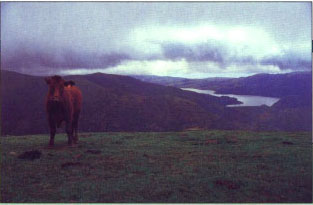All Issues
San Francisco water district targets cattle
Publication Information
California Agriculture 51(2):7-7.
Published March 01, 1997
PDF | Citation | Permissions
Full text
In February, the San Francisco Public Utilities Commission (PUC) seemed poised to ban cattle from its southern Alameda County watershed. In announcing a possible moratorium on livestock grazing, the commission cited concerns about contamination of the water supply with Cryptosporidium, a waterborne intestinal parasite carried by a wide range of animals, including cattle and humans (see page 8 ).
The proposal met with strong opposition, not only from the 15 ranchers with grazing leases in the watershed, but also from the Alameda County Resource Conservation District (RCD), which has been working to improve water quality and biodiversity in the Alameda Creek watershed. In March, the PUC agreed to consider an alternative plan that would include risk assessment and monitoring programs to guard against Cryptosporidium and other waterborne pathogens. The Alameda RCD and the livestock industry have until April 30 to submit a comprehensive “best management practices” plan to the PUC.
“The commission will decide in May whether to limit or ban grazing,” says Sheila Barry, a watershed specialist with the Alameda RCD. In the meantime, a multidisciplinary technical team, including specialists from UC Cooperative Extension and other agencies, is working to put together a plan that will address the potential hazards from livestock grazing and other possible sources of waterborne pathogens.
The plan will apply the principles of recent food safety programs to water quality. So-called Hazard Analysis and Critical Control Points (HACCP) concepts were developed to evaluate, manage, and monitor risks in food. “We want to take a systematic approach, looking at the entire watershed and all of the potential sources of contamination,” says Barry.
Cryptosporidium made headlines in 1993 when it got into the Milwaukee water supply, causing 100 deaths and making 400,000 people sick with stomach cramps and diarrhea. The illness (cryptosporidiosis) lasts only a few days in most people with healthy immune systems, but those with severely weakened immune systems can develop chronic, life-threatening infections. Those at greatest risk include AIDS patients and people taking immunosuppressive drugs, such as some cancer chemotherapies.
The PUC's action to ban cattle was taken at least partly in response to pressure from people with HIV. Cryptosporidium is particularly worri-some because, unlike other disease-causing organisms that can contaminate water supplies, it is resistant to chlorine-based disinfectants used in water treatment plants. Furthermore, there is no effective medical treatment for cryptosporidiosis.
Although cattle are often suspected as sources of Cryptosporidium, studies have not established a clear link between livestock and the presence of Cryptosporidium in lakes and streams. Surveys indicate that Cryptosporidium is common in untreated surface water throughout North America. In addition to cattle, numerous wildlife species carry the parasite and shed it in their feces. These include elk and feral pigs, which experts say would proliferate in the Alameda watershed if cattle were removed.
Surveys conducted by Rob Atwill, a Cooperative Extension veterinarian and assistant professor at the UC Davis School of Veterinary Medicine, show that in an infected herd, only calves up to 4 months old shed Cryptosporidium, while older cattle are not significant sources. Making sure that young calves do not graze near streams or reservoirs would eliminate most of the risk of contamination from cattle, says Atwill.
The plan submitted to the PUC will include a range of cattle management practices that could be implemented to minimize any risks associated with grazing, says Atwill. More research is needed to assess the risk of Cryptosporidium contamination from other potential sources, particularly wildlife species that inhabit riparian areas.





